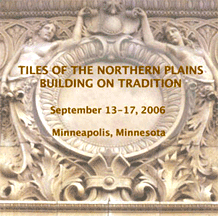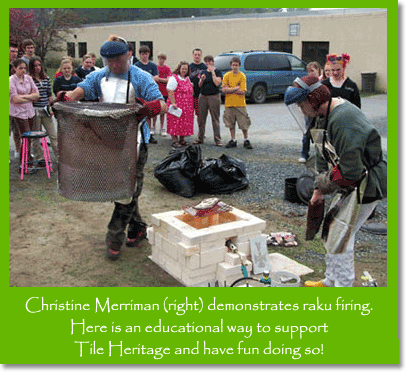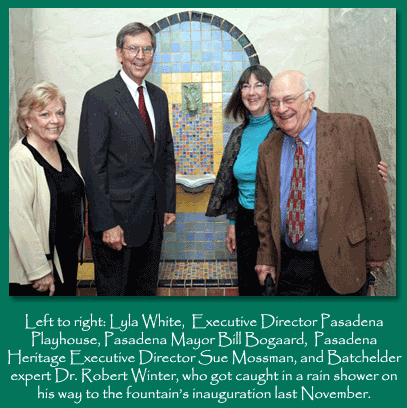

The closing of the Hans Sumpf Company in Madera, California cuts deep
into the heart of the contemporary clay world. Here was a company
that during its 70-year history had perfected a much-needed product
(a durable, waterproof adobe brick) and later created a unique
ceramic milieu (sculptured wall surfaces in clay). In addition, the
different ceramists in charge were willing to focus their expertise
in an area where others feared to tread, namely the production of
clay pavers and roof tiles that exactly matched their historic
predecessors.
Hans Sumpf died unexpectedly in 1985. His wife, Louise, maintained
control of the company until her death last year. Their children,
although recognizing their father’s legacy, have no personal
interest in the company. In fact, the land on which the company is
situated, as well as the other land owned by the company, is worth
far more than the company would ever be, many times over. This is
their heritage; these are the times in which we live.
The dates, teachers, locations and listings are now available, along with a full description of each
workshop and printable registration forms.
NCECA 2006 — 40th Annual Conderence will be held March 8-11 at the
Oregon Convention Center in Portland, Oregon. “Explorations and
Navigations: The Resonance of Place” was inspired by the
explorations of Lewis and Clark, who ended their long journey near
Portland over 200 years ago. The conference is expected to attract
over 4000 attendees who will participate in a full array of panels
and lectures dealing with varied aspects of the ceramic arts. More
than 100 exhibitions have been especially mounted in galleries and
museums to coincide with the event. For details visit www.nceca.net
or call either Ted Vogel (503 768-7398) or Thomas Orr (503 297-5544,
ext. 128).
SAMA 2006,
“Beneath the Surface,” will be held March 15-18 at the
Chicago Holiday Inn Mart Plaza. The Society of American Mosaic
Artists plans two full days of mosaic workshops, bus and walking
tours to selected installations, lectures and panel presentations,
various receptions and exhibitions as well as the closing night
party. For details go to www.americanmosaics.org (click on
Conference) or email Dawnmarie Zimmerman at
operations@americanmosaics.org.
See you there!
Your Coverings experience, April 4-7, will be enriched by an ongoing,
big-screen, presentation of architectural masterpieces from around
the world. Centrally located in the main lobby of the Orange County
Convention Center, the visual display of historic tile, stone and
mosaic installations will capture the attention of all passers-by
with its size, color and design. From the ruins of the Roman Empire
to the majestic remains of medieval abbeys, from the ornate royal
palaces of Portugal to the grand tiled mansions along the California
coast, this exhibition, sponsored by Coverings and produced by the
Tile Heritage Foundation with technical assistance from Audio Visual
Innovations (AVI), will provide its viewers with a unique, dramatic
experience, leaving all both inspired and entertained.
(Available each month to Tile Heritage members who e-mail the Foundation from the address they
would like
E-News sent to. Contact: foundation@tileheritage.org)
PRINTED VERSION

Here’s What’s Below:
Hans Sumpf Co. Closes

Hans Sumpf:
A Small Giant Succumbs to the Times

From our perspective at Tile Heritage, Hans Sumpf has
been an invaluable and irreplaceable resource.
Hans Sumpf, the man, was born in Coalinga, California in 1914, the
son of a German immigrant. He studied engineering at Stanford, and in
the mid-1930s he borrowed $300 from his father and developed a
formula, an asphalt emulsion, for waterproofing adobe, a traditional
building material in the Southwest. He partnered with George
MacFadden, an expert on adobe; they traded bricks for land—and made
more bricks. A major flood inundated Fresno in 1939; in the
aftermath, Hans was invited by many homeowners to make bricks in
their front yards! An early job was the restoration of the Mission at
San Juan Bautista. For those who drive on Highway 101, south of
Gilroy, the mission’s shrine on the highway is also made with Hans
Sumpf adobe. The company also supplied adobe and roofing tiles for
the restoration of earthquake-ravaged Mission San Jose in Fremont.

Although the bricks were sun-baked, Hans bought a kiln in the mid-50s
to achieve a red-colored brick. The experiment proved
unsuccessful, and the kiln remained idle until Hans met ceramic artist
Stan Bitters and invited him to set up his studio at the Sumpf site
in Madera. Stan created the sculptured wall surfaces that became the
artistic hallmark of the company, textured ceramic wall adornments
that covered the exteriors and lobbies of many commercial buildings
in the Central Valley and beyond. Others followed in his footsteps
(among them John Bennett, Sam Trujillo, Rick Anderson, Scott Vaughn,
Hans Tegebo) but each artist lent his own personal style to the
finished product.
Tom Bryan has been the head ceramist for the

last
twenty years and has served as the company’s last president. His
final job has been the reproduction of floor tiles for the Biltmore
Hotel in Santa Barbara.

Closing with a staff of six, the company
ends small and yet a giant
in its specialized field. We would like to extend our thanks and
appreciation to all those who over the years have produced a product
of such remarkable distinction. To Tom Bryan and to Bobbie Kemp Van
Ee, the company’s secretary/treasurer who served as Mrs. Sumpf’s
private secretary for 28 years, we offer a warm salute as only fired
clay can provide.
THF
Workshops Posted!
The Tile Heritage Foundation is presenting eight (8) workshops in
2006 as part of “Keeping the Craft Alive” There is a fine array
of offerings at many skill levels including architectural ceramics,
image transfer techniques, mosaic, raku tiles, sculptural tile
making, slab-rolled ware and Talavera-style tile painting. Teachers
this year include: Donna Billick, Irene de Watteville, Douglas Gray,
Christine Merriman, Sheila Menzies, Sheryl Tuorila, Mark Tomlinson
and Ivette Vaillard.
Upcoming
Events

 Coverings will once again be held at the Orange County Convention
Center in Orlando, April 4-7. This is the most comprehensive tile and
stone marketplace in the Americas, and the preferred forum for hard
surface education, exhibits and purchases. The exhibit floor spans
over 505,000 net square feet, which puts Coverings firmly in the top
30 events in the United States in terms of exhibit space. There will
be attendee representation from approximately 100 countries,
attesting to Coverings’ integral role in the tile and stone
marketplace. Likewise, Coverings packs the most purchasing power of
any tile and stone exposition. More than 32,000 industry
professionals from around the world are expected to converge in
Orlando at Coverings 2006! And Tile Heritage will be there, under the
Canadian, Mexican and U.S. flags, in Booth 2816.
Coverings will once again be held at the Orange County Convention
Center in Orlando, April 4-7. This is the most comprehensive tile and
stone marketplace in the Americas, and the preferred forum for hard
surface education, exhibits and purchases. The exhibit floor spans
over 505,000 net square feet, which puts Coverings firmly in the top
30 events in the United States in terms of exhibit space. There will
be attendee representation from approximately 100 countries,
attesting to Coverings’ integral role in the tile and stone
marketplace. Likewise, Coverings packs the most purchasing power of
any tile and stone exposition. More than 32,000 industry
professionals from around the world are expected to converge in
Orlando at Coverings 2006! And Tile Heritage will be there, under the
Canadian, Mexican and U.S. flags, in Booth 2816.
Stop by and say
“hello”!
 Tile Festival 2006
will be held on the grounds of the Moravian
Pottery and Tile Works, Doylestown, PA, on Saturday and Sunday, May
20 & 21. This annual event will include quality tile artists and
makers, and dealers of historic tiles from around the country who
will gather to display a large and unique selection of ceramic art
tiles. Like in past years, beautiful and rare examples of handcrafted
tiles will be displayed and available for sale during this event.
Public support of this special occasion continues to grow each year.
Last year’s event drew over 1600 visitors. Proceeds benefit the
curatorial and educational programs of the Moravian Pottery and Tile
Works. For further information, call Vance Koehler at (215) 345-6722
ext. 26 or email vakoehler@co.bucks.pa.us.
We’ll see you there!
Tile Festival 2006
will be held on the grounds of the Moravian
Pottery and Tile Works, Doylestown, PA, on Saturday and Sunday, May
20 & 21. This annual event will include quality tile artists and
makers, and dealers of historic tiles from around the country who
will gather to display a large and unique selection of ceramic art
tiles. Like in past years, beautiful and rare examples of handcrafted
tiles will be displayed and available for sale during this event.
Public support of this special occasion continues to grow each year.
Last year’s event drew over 1600 visitors. Proceeds benefit the
curatorial and educational programs of the Moravian Pottery and Tile
Works. For further information, call Vance Koehler at (215) 345-6722
ext. 26 or email vakoehler@co.bucks.pa.us.
We’ll see you there!

“Tiles of the Northern Plains: Building on Tradition” will be held
September 13-17, 2006 in Duluth and Minneapolis. The focus of the
conference will be on the remarkable achievements of local tile
makers and mosaic artists as well as the historic traditions that
have nurtured this development. There will be tours, both guided and
self-guided; presentations by noted tile historians; studio
demonstrations and workshops where participants will get a firsthand
view of all the goings on; and exhibitions, at least two planned at
this time, that will feature contemporary tile work and its historic
predecessors. Keep these dates free: September 13-17, 2006. The
conference is being presented by the Handmade Tile Association and
the Tile Heritage Foundation.
We all look forward to seeing each other there! Details forthcoming.
As one of the great institutions of the American theatre since 1917, the Pasadena Playhouse remains committed to the development and presentation of a culturally diverse variety of theatrical productions at the highest level of artistry.
In May of 1925, a beautiful new theater, one of the first in southern California, was unveiled on South El Molino Avenue. Opening night was a magical evening, full of lights, and the scent of jasmine, celebrities, memories and, most of all, promise. Architect Elmer Grey’s jewel of a building took center stage, appropriately adorned as it was with a wall fountain designed and fabricated by Batchelder- Wilson, the enterprising tile manufacturer in nearby Lincoln Heights.
As part of a recent $8.5 million renovation of the famous playhouse, the Batchelder fountain was restored to its original glory. The focal point of the piece is a 4 x 8-inch dolphin fountainhead that had been destroyed by vandals in the mid-1970s. The Tile Heritage Foundation was able to locate an illustration of the original dolphin in its archives, which was subsequently given to master ceramist Jim Sullivan at Sullivan Ceramics in Topanga, California, who produced the replica. Amy Green at Silverlake Conservation took charge of the restoration, cleaning and repairing of the fountain itself, a $16,000 project.
Today, the theatre produces a year-round six-play season of 275 performances featuring over 100 artists, designers, directors and playwrights. More than 130,000 patrons visit each year, including over 12,000 subscribers who travel from 400 zip codes. Imagine all those people coming face to face with a beautifully restored Batchelder fountain!
Not an especially common term in the States, a gazetteer is a
dictionary or index of geographical names… so? Well, we can now
safely, proudly in fact, report that the UK has been thoroughly
gazetted. Lynn Pearson, a member of the tile society’s committee in
England (TACS), with the assistance of numerous volunteers, has been
gazetting about for the last 10 years or more recording in situ
installations of tiles and architectural ceramics. The result is the
recently published, soft-cover book titled Tile Gazetteer: A Guide to
British Tile and Architectural Ceramics Locations. The fully packed
512 pages are startling in the sheer density of their content. Far
from a mere listing, each site —and there are hundreds upon
hundreds—is described in full historic detail! The body of the book
is organized alphabetically by county, first in England, then in
London proper by borough, and then in Isle of Man, Scotland and
Wales. Within each section the geographic sites with installations
are also arranged alphabetically and referenced for future research.
And, most importantly, there is an index of places, another for
artists, designers and manufacturers (and a biographical directory of
same), plus a glossary and bibliography. This is a fully equipped
guidebook for sure! The pièce de résistance is found in
“Introduction: Decorative Ceramics in Architecture” where many of
the leading tile scholars in England share with us their perspectives
and expertise on various subjects—tidbits of wisdom from those who
have dedicated their professional lives to the preservation of our
favored ceramic gems. It should be mentioned also that there are two
full-color sections in the book, each with superb photography, and
occasional black and white pictures throughout that accompany the text.
Who should own this book? Any tile enthusiast, especially those who
have visited the UK or those who dream of doing so in the future! To
obtain a copy, email Chris Blanchett at Buckland Books
buckland.books@tiscali.co.uk.

What’s a Gazetteer?
Now we know!



